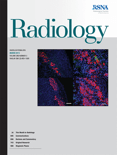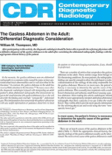
RADIOLOGY
metrics 2024
Fostering knowledge for the next generation of radiologists.
Introduction
RADIOLOGY, published by the Radiological Society of North America (RSNA), stands as a premier journal in the fields of radiology, nuclear medicine, and imaging. Established in 1945, this esteemed journal has consistently provided groundbreaking research and insights, helping to shape advancements in diagnostic imaging and therapeutic interventions. With a commendable Q1 ranking in its category and a remarkable 99th percentile ranking in Scopus, RADIOLOGY continues to be a pivotal resource for clinicians, researchers, and students alike. Although not an Open Access journal, it offers a wealth of high-quality peer-reviewed articles that contribute significantly to the ongoing discourse in the medical community. With a strong focus on innovative techniques and the integration of new technologies, RADIOLOGY remains essential for professionals aiming to stay at the forefront of medical imaging practices.
Metrics 2024
 3.69
3.69 12.10
12.10 13.40
13.40 336
336Metrics History
Rank 2024
Scopus
IF (Web Of Science)
JCI (Web Of Science)
Quartile History
Similar Journals

Japanese Journal of Radiology
Elevating Radiology Research to New HeightsThe Japanese Journal of Radiology, published by SPRINGER, serves as a premier platform for disseminating cutting-edge research and clinical advancements in the fields of radiology, nuclear medicine, and imaging. With an ISSN of 1867-1071 and E-ISSN 1867-108X, this journal has established itself as a vital resource for practitioners, researchers, and students alike. Renowned for its high-quality peer-reviewed articles, it currently enjoys a respectable impact factor within the Q2 category of Scopus rankings, placing it in the 69th percentile among 333 journals in its field. The journal has seen consistent convergence of research from 2009 to 2024, further underscoring its commitment to advancing the understanding of radiological practices. Importantly, the journal offers Open Access options to facilitate widespread dissemination of knowledge, ensuring that vital research reaches its audience without barriers. Addressed in Japan, the Japanese Journal of Radiology plays a critical role in enhancing the global discourse on medical imaging, making it an essential resource for anyone engaged in this dynamic field.

SA Journal of Radiology
Advancing Radiology: Bridging Knowledge and InnovationThe SA Journal of Radiology is a prominent open-access journal published by AOSIS, dedicated to advancing knowledge in the fields of Radiology and Ultrasound Technology. Established in 2004, this South African journal provides a platform for researchers, professionals, and students to disseminate valuable findings and share innovative practices in medical imaging. With an ISSN of 1027-202X and an E-ISSN of 2078-6778, the journal has become an important resource for those involved in radiological sciences, despite currently holding a Q4 ranking in both Radiological and Ultrasound Technology and Radiology, Nuclear Medicine and Imaging categories. Covering a converged time span from 2014 to 2024, the journal aims to promote scholarly communication and enhance the accessibility of research, positioning itself as a key player in the global radiological community. In a landscape where open access is increasingly critical, the SA Journal of Radiology is committed to fostering research collaboration and facilitating the exchange of ideas among clinicians and academics alike.

European Radiology Experimental
Bridging Clinical Practice and Cutting-Edge ResearchEuropean Radiology Experimental is a premier open-access journal published by Springer Wien, dedicated to advancing the field of radiology through innovative research and experimentation. Since its establishment in 2017, the journal has quickly gained recognition, evidenced by its impressive Q1 ranking in the Radiology, Nuclear Medicine and Imaging category, and its placement within the top 83rd percentile of the Scopus rankings. Based in the United Kingdom, this journal aims to bridge the gap between clinical practice and cutting-edge research, providing a platform for rigorous peer-reviewed articles that explore new methodologies, technologies, and insights in radiological sciences. With a commitment to open access, European Radiology Experimental ensures that its content is readily accessible to a global audience, supporting the dissemination of knowledge and fostering collaborations among researchers, professionals, and students in the medical imaging community. As it progresses through its convergence years, the journal continues to play a vital role in shaping the future of radiological research and practice.

Insights into Imaging
Shaping the Future of Medical Imaging ResearchInsights into Imaging is a prominent open-access journal published by SPRINGER WIEN, specializing in the dynamic fields of radiology, nuclear medicine, and imaging, with its ISSN 1869-4101. Established in 2012, the journal has established itself as a leading platform for disseminating high-quality research and innovative findings, currently holding a prestigious Q1 ranking in its category as of 2023. With an impressive Scopus rank of #42 out of 333 in the medicine discipline, the journal is positioned in the 87th percentile, reflecting its significance and influence in the academic community. Based in Germany, Insights into Imaging not only provides unrestricted access to research but also aims to bridge the gap between scientific inquiry and clinical application, making it an essential resource for researchers, professionals, and students engaged in advancing imaging technologies and practices. The journal’s commitment to fostering knowledge exchange ensures that it remains a critical contributor to the evolving landscape of medical imaging, with articles available from 2012 through 2024.

Journal of the Belgian Society of Radiology
Pioneering Innovations in Imaging and Nuclear MedicineThe Journal of the Belgian Society of Radiology, published by UBIQUITY PRESS LTD, is a pivotal resource in the field of radiology, nuclear medicine, and imaging. With an ISSN of 2514-8281 and E-ISSN of 2514-8281, this open access journal has been dedicated to fostering the dissemination of high-quality research since its establishment in 2010. Distributed from the United Kingdom, it offers a platform for innovative studies, case reports, and reviews that contribute to the advancement of radiological sciences. Despite its current Q4 category ranking within Scopus, the journal plays a critical role in sharing essential findings with a community of over 1,200 professionals and students eager to stay abreast of emerging trends and technological advancements in imaging. By enabling unrestricted access to its publications, the journal encourages collaborative research and knowledge exchange that transcends geographic boundaries, solidifying its importance for both established researchers and emerging scholars in the discipline.

Tomography
Elevating the standards of medical imaging research.Tomography is an esteemed peer-reviewed journal published by MDPI, focusing on a broad spectrum of topics related to medical imaging and diagnostics. Launched in 2015, this Open Access journal serves as a vital platform for researchers, professionals, and students in the fields of medicine, radiology, nuclear medicine, and imaging. With an impressive impact factor reflecting its relevance, the journal has achieved a quartile ranking of Q2 in both Medicine (Miscellaneous) and Radiology, Nuclear Medicine, and Imaging as of 2023. Renowned for disseminating high-quality research, Tomography welcomes original research articles, reviews, and technical notes, fostering innovation and collaboration within the scientific community. Housed in Basel, Switzerland, the journal aims to bridge the gap between fundamental research and clinical application, appealing to a diverse readership eager to advance the field of medical imaging.

Indian Journal of Radiology and Imaging
Connecting Global Minds in Radiology and ImagingThe Indian Journal of Radiology and Imaging, published by THIEME MEDICAL PUBL INC, is a prominent open-access journal in the field of radiology, nuclear medicine, and imaging. Since its inception in 1984, the journal has provided a platform for researchers, professionals, and students to disseminate innovative research and findings in diagnostic imaging. With a growing impact factor and categorized in the Q3 quartile according to the 2023 rankings, it ranks among the notable journals in its field, although it currently stands at Rank #244 out of 333 within Scopus, reflecting its competitive position in radiology research. The journal, accessible to a global audience since 1999, aims to advance the knowledge and practice in imaging by inviting diverse contributions, including original research articles, reviews, and case reports. Its commitment to open-access publication fosters wider dissemination and collaborative discourse, crucial for the dynamic landscape of medical imaging.

KOREAN JOURNAL OF RADIOLOGY
Pioneering Research in Radiology and Nuclear MedicineKorean Journal of Radiology (ISSN: 1229-6929, E-ISSN: 2005-8330), published by the Korean Society of Radiology, stands as a leading international platform for the dissemination of high-quality research and advancements in the fields of radiology, nuclear medicine, and imaging. With a remarkable impact factor and ranked in the Q1 quadrant in its category, this journal showcases cutting-edge studies, clinical investigations, and comprehensive reviews that significantly contribute to the understanding and practice of medical imaging. Researchers, clinicians, and students alike will find the journal an invaluable resource, featuring innovative methodologies, case studies, and essential updates in imaging technology. Since its inception in 2000 and continuing through 2024, the Korean Journal of Radiology remains dedicated to promoting excellence and fostering collaborative research within the global radiology community, underscoring the importance of imaging in modern medicine.

ROFO-FORTSCHRITTE AUF DEM GEBIET DER RONTGENSTRAHLEN UND DER BILDGEBENDEN VERFAHREN
Exploring Breakthroughs in Radiology and Nuclear MedicineROFO-Fortschritte auf dem Gebiet der Röntgenstrahlen und der bildgebenden Verfahren, published by Georg Thieme Verlag KG, is a pivotal journal in the fields of radiology and nuclear medicine, offering invaluable insights for researchers, healthcare professionals, and students alike. With an ISSN of 1438-9029, this journal has been a stalwart of scientific communication since its inception in 1975, actively contributing to advancements in imaging techniques and radiation therapy. Although it operates under traditional access, the journal maintains a respectable standing, reflected by its Q3 ranking in Radiology, Nuclear Medicine and Imaging and Q4 in Medicine (miscellaneous), highlighting its significance in the scholarly community. Its coverage spans a wide array of topics pertinent to diagnostic imaging and therapy protocols, making it an essential resource for anyone seeking to understand the complexities of modern radiological practices. As the journal continues to evolve through 2024, it invites contributions that enrich the dialogue around technological innovations and clinical applications in the realm of imaging modalities.

Contemporary Diagnostic Radiology
Shaping the Landscape of Radiological ScienceContemporary Diagnostic Radiology is a pivotal journal in the field of medical imaging and radiology, published by Lippincott Williams & Wilkins. With an ISSN of 0149-9009 and an E-ISSN of 1938-1395, this journal serves as an essential platform for disseminating high-quality research and advances in diagnostic radiology and related disciplines. While it is categorized in the lower quartiles (Q4) for its performance in the 2023 rankings in both Neurology, Radiology, Nuclear Medicine and Imaging, and Surgery, its focus on emerging technologies and methodologies in imaging continues to provide valuable insights for practitioners and researchers alike. The journal’s scope includes innovative diagnostic tools, imaging techniques, and case studies, fostering collaboration and knowledge sharing in the medical community. Although it does not offer open access options, its commitment to contributing to the ongoing dialogue in clinical imaging is undisputed, making it an essential resource for professionals seeking to stay abreast of current trends and research in the rapidly evolving landscape of diagnostic radiology.